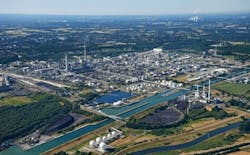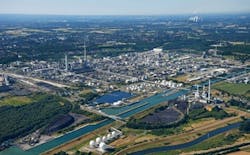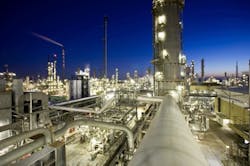Predictive Maintenance: Plants Hit the Data Jackpot
Chemical makers will see plant operating staff spending far less time collecting and managing data and far more time focusing on critical value-added work and decision-making, says Mark Granger, reliability solutions manager at Emerson Process Management, Knoxville, Tenn. In five years, the continued technology advancements that Emerson and other vendors are driving will result in more smart assets and systems that monitor themselves and their processes, he believes. Moreover, multiple groups within a company will take advantage of the embedded smart information from the plant. Predictive maintenance (PdM), condition monitoring, and asset performance details will become more closely integrated with control optimization and, thus, will play an increasing role in improving availability, throughput, health/safety/environmental (HSE) efforts, operations and maintenance, and plant life. “The boundaries between control, reliability, PdM, operations, safety and production are getting more blurry for the chemical plant of the future,” he stresses.
Efforts both by chemical makers and vendors are fostering this future.
For instance, Evonik, Essen, Germany, is focusing on using big data as a new digital process optimization tool — especially in terms of PdM.
[javascriptSnippet ]
“The importance of big data simply cannot be emphasized enough. Most companies are fully aware of the significance and potential of digitization. The actual challenge here is to make selective use of this wealth of data for the classic purposes of a manufacturing organization: for increasing productivity, optimizing processes, and becoming more efficient,” explains Kai Dadhe, who heads the manufacturing intelligence group in the company’s performance intermediates business line.
The tools traditionally used for optimizing processes are reaching their limits — with the challenge compounded because linking and networking isolated data silos around the chemical plant remains difficult and fraught with obstacles, believes Dadhe.
“The result? Our view of the overall production process is obscured, preventing us from recognizing optimization potential and capitalizing on improved efficiency,” he says.
Big data combined with existing process experience and expertise in interdisciplinary optimization programs is the way forward, Dadhe reckons.
In practice, this means collecting, storing and strategically using the continuous flow of data from modern instruments, equipment, etc., in a way that allows staff to identify operating conditions with greater precision, and that makes error analyses simpler and more accurate. This fosters reliability and transparency that, in turn, enable tailoring repairs and maintenance for each individual piece of equipment.
“What is clear about big data is that it changes the way individual parts of the company deal with data, makes digital information more important, incorporates this information in every decision-making process, and blurs the boundaries between disciplines and divisions within the company — it’s a challenge for everyone, in other words, and one that requires professional moderation and support.”
Figure 1. Multi-disciplinary project at the site is evaluating the potential of digital information to improve predictive maintenance. Source: Evonik.
Pilot Project
In a new development that builds on this, Evonik’s intermediates business line has teamed up with its process technology and engineering business line and its global information technology and processes department to pursue a pilot project at its Marl, Germany, complex (Figure 1) aimed at taking a detailed look at the potential that digital information holds for defined production processes.
Described as a “tremendous leap” by Dadhe, the project explores how to use big data for optimizing processes from many different perspectives — including technical and business — while incorporating expertise from throughout the entire company. The objective of the project is two-fold: implementing PdM, and addressing concrete process issues.
A key PdM issue is whether digital intelligence can enable creating more efficient and flexible maintenance and repair routines for specific machines that are particularly susceptible to material deposits. Such deposits negatively impact process efficiency and lead to increased repair work, he says.
“By using and analyzing all of the digital measurement data available, the team hopes to explain how the deposits arise in the first place, what process parameters encourage their formation, and how they can be reduced. The objective is to develop suitable maintenance tools that will minimize this negative influencing factor and save money,” he explains.
Meanwhile a sub-project focuses on undesirable fluctuations affecting a specific material property in a large-scale technical process — a phenomenon that often occurs during chemical production.
Here, the team hopes to use big data to clarify why this parameter varies and which preceding process step is responsible. For example, could it result from fluctuations in the composition of precursors or intermediates? “These studies clearly demonstrate that finding errors and sources of error quickly and with certainty means having to look at the entire supply chain,” notes Dadhe.
While existing data can serve as a tool for validating or refuting expert hypotheses regarding the sources of error, Dadhe stresses that employees are learning to identify cause-effect relationships within a complex digital space and to apply that knowledge to real-life production issues. In other words, they are learning to use and trust data.
“If the project is successful in its aim of improving efficiency and system availability while ensuring product characteristics, the benefits will extend beyond the directly affected area of the company. Success will instead confirm that the tremendous potential that big data holds for the entire supply chain is more than just theory,” he concludes.
Figure 2. Putting new sensors on steam cracker at Ludwigshafen was one of the first moves in predictive maintenance initiative. Source: BASF.
Major Initiative
BASF, Ludwigshafen, Germany, also is taking a broader look at the usefulness of digital information, with PdM an integral part of its “Industry 4.0” activities that were launched in 2015. Designed to drive digital transformation, the initiative aims to use digital technologies to increase the effectiveness and efficiency of processes and to develop new digital products and services that offer greater added value for customers.
At the moment, multi-disciplinary teams are carrying out pilot and “lighthouse” projects in Ludwigshafen and at other sites worldwide to test the potential of various applications. Successful pilot projects and applications eventually will be implemented on a larger scale.
One of the five lighthouse projects focuses on smart manufacturing and, here, the company is implementing digital technologies and applications in its plants to make production safer and more efficient.
As part of this project, the first PdM applications were installed in the steam cracker in Ludwigshafen (Figure 2) to forecast the condition of equipment such as pumps and motors. Sensors collect live data about operating conditions, which then are evaluated with special analysis software, taking into consideration historical process data such as maintenance history.
“The objective here is to predict the best timing for maintenance measures. This will help reduce unplanned repairs and downtime, and optimize the coordination of maintenance and production processes,” says a spokesman.
The smart manufacturing project also is undertaking projects that use augmented reality. For example, employees can access on tablets the relevant repair manuals and instructions based on their particular location and situation, making work processes more efficient.
“The necessary apps, such as for plant maintenance, have been developed in a collaboration between engineers, programmers and employees of the pilot plants,” notes the spokesman. Further details about how the apps work, and about the steam cracker PdM project, won’t be available until nearer the end of the year, he adds.
Pioneering Industry
The chemical industry has a reputation for conservatism. However, the Evonik and BASF projects exemplify how the industry is a leader in efforts to enhance PdM, a point Emerson’s Granger emphasizes.
“The chemical industry is a mature user of predictive maintenance and most of the best PdM/reliability programs that I have seen implemented have been in this industry. PdM has proven itself as an effective business strategy for HSE, driving down maintenance costs, and improving availability and throughput. As a result, it has received more top-level management support than in other industries,” he says.
The findings of a recent chemical industry survey by Emerson point to a substantial benefit from a PdM program — the plants responding averaged a 625% return on investment (based on an average benefit of $2 million with an average cost of $320,000). Major savings came in production (42%), parts (21%), labor (15%) and quality/scrap (10%). That survey also indicates the plants used at least five PdM technologies and achieved their major cost benefits by monitoring vibration (40%), thickness (33%) and tribology (10%). In addition, it found that PdM staff in general were highly trained and PdM was viewed as an essential core competency.
However, technology is advancing and business drivers are changing, says Granger. The days of PdM as a siloed department utilizing portable technologies and standalone software are numbered, he believes.
Figure 3. Hand-held device makes asset condition information more readily available, enhancing decision-making. Source: Emerson Process Management.
“In general, PdM is becoming more automated (collection, interpretation, reporting) and the resultant information is being more broadly used throughout the plant for better overall management. An example of this would be the automatic notification to operations and control when a production-critical compressor falls out of best operating efficiency range along with providing detailed performance information so that throughput and energy cost can be optimized,” he notes.
In addition, bringing live process control parameters like pressures and temperatures into the PdM analysts’ diagnostics software provides greater ability to understand the situation.
For its part, Emerson is striving to simplify this by moving to a common look and feel for its devices as well as plug-and-play integration. This means, for example, that a pressure transmitter can be set up and maintained just like a vibration transmitter, using the same tools; and the control system, historians and existing asset management software can easily access the data generated. “The information from all the technologies is now like puzzle pieces that fit together to form a much clearer view of plant health and performance,” Granger explains.
Another step in this process is Emerson’s launch of the ARES asset management platform. It can deliver a wide selection of information to tablets and smart devices (Figure 3) as well as personal computers, both inside and outside the plant. “Basically, it culls through mountains of data to find the specific functional information needed by each user to ensure the plant runs safely, effectively and efficiently,” he adds.
Updated Application
Meanwhile, Yokogawa Corp. of America, Sugar Land, Texas, has launched version R3.30 of its plant resource manager (PRM) tool for the centralized management of large amounts of data from plant monitoring and control devices and manufacturing equipment. It includes an improved management function for HART devices and enhanced navigation. R3.30 now covers applications as diverse as pressure transmitters, magnetic flow meters, valve health and gland packing. In addition, key performance indicators monitored include pump and heat exchanger diagnostics.
PRM has been installed in a broad variety of chemical sites already. For example, a recent project at Asahi Kasei Synthetic Rubber Singapore, Jurong Island, Singapore, focused on a polymerization process and its associated raw material and chemical feeding, recovery, finishing and utility processes. Here, PRM checked all control loops and valves during commissioning. Now, operators are using PRM daily to monitor every field device from a central control room. This has reduced workload in the field and enabled a much more proactive PdM strategy, lessening the likelihood of unscheduled plant shutdowns.
In Europe, following installation of PRM, the MOL Danube Refinery in Százhalombatta, Hungary, immediately saved between $20,000 and $70,000 per turnaround on control valves alone. The software essentially allows MOL to carry out detailed diagnostic checks on each control valve prior to scheduled maintenance, thus avoiding unnecessary work and expense.
Commenting on the project’s success, Gábor Bereznai, head of control and electrical engineering at the refinery, cautions: “I think many companies, including the big ones, often underestimate the need to improve both the process and the human side of the activity. That’s why many times they are not able to fully utilize the benefits of available and installed technology.”




